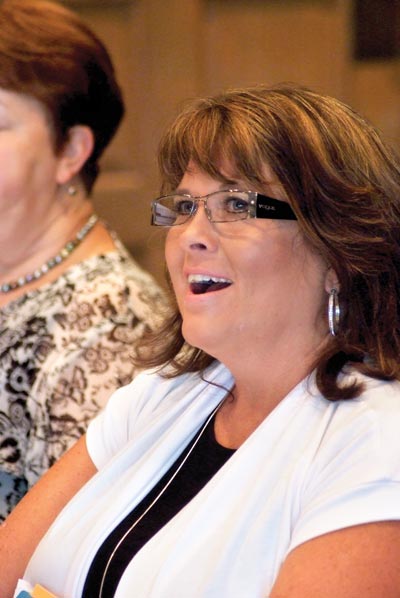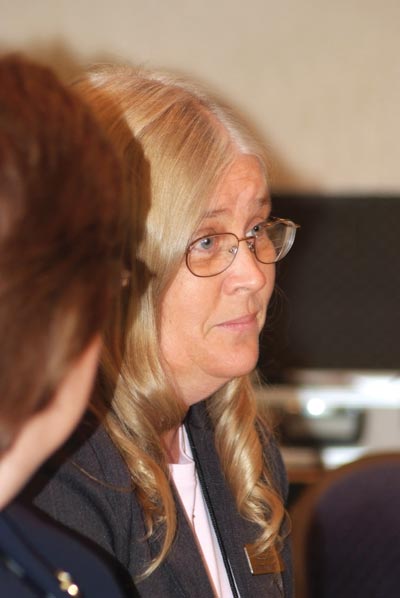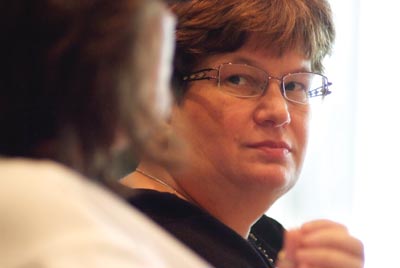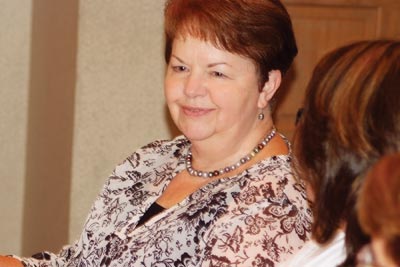
Five of the area’s top education professionals sat down with Lake & Sumter Style for an in-depth interview concerning the state of our schools. We discussed how the budget quagmire was ultimately resolved, what our kids will face in the coming school year, and the long-term problem of the methodology in which Tallahassee pays the bills. How will these larger issues affect your family and your kids? Read on.


We figured the best way to get the in-the-know answers was to gather a hand-picked group of top education officials together to ask them a series of tough questions face to face. Over a 90-minute luncheon in a private room at the expansive Mission Inn Resort & Club on an uncharacteristically mild summer morning, Editor-In-Chief Dean Blinkhorn hosted a unique forum where the camera was clicking and the tape was rolling.
Here’s what everyone had to say.
‘A Part Of The Team’
Why did you choose education?
Susan: I was a business educator and then came through the ranks as an occupational specialist, assistant principal, principal, and director of a technical center. I’m very passionate about students and lifelong learning.
Carol: I worked for the Florida Auditor General’s office for 14 years, and one of my primary responsibilities was auditing the school board. And they still hired me. [laughs] I can be an accountant anywhere, but to be able to support the educational mission of the district is personally fulfilling.
Linda: We moved to Wildwood in ’81, and I volunteered at my children’s schools. I’m not a politician—I never dreamed of being on the school board. Basically, I’m a professional volunteer.
Debbie: I married into a family of educators, and I guess I caught the bug. I taught elementary and middle school; I’ve been an assistant principal, a principal, and a senior director for the system. I taught eight-grade math in the same room I had eighth-grade math. I had teachers that my dad had, and my son’s had teachers that I had. What I think is important is giving back to the community and making it a better place.
Shirley: Like Carol, I can work anywhere, but about five years ago, the opportunity arose to work with the school district. Like Debbie, I’m a product of the Sumter County school system, as well as my two children. I feel like I can be a part of the team that tries to maximize the education dollar for our children.
‘Money Talks’
One of the biggest challenges our communities face is keeping good teachers. Statistics show that a large percentage of teachers vacate the system within three to five years. What do you do here locally to keep teachers in your system?
Linda: When I came on board, we had to bring our beginning salary up to a commensurate level. That has helped us immeasurably to compete in Florida and the Southeast. Also, training and re-training current and new teachers is key.
You think salary is where it starts, though?
Susan: Yes, money talks. Lake County has always been a very high-growing district, and having highly qualified teachers was definitely a priority to meet the needs of our growth. So we did work, like Sumter, to make sure our salaries were competitive with our surrounding districts and to be competitive with other industries, especially academic specialties like math and science.
We also want to make sure our teachers have the tools to work efficiently and effectively. We look at professional development not only from the how-to-teach but the what-to-teach, making sure they understand the standards and the benchmarks and appropriate assessment. The other thing that we did, and Sumter probably has similar programs, is we attracted a lot of individuals from industry.
 In this economic downturn, are you seeing more people come over from private industry into teaching?
In this economic downturn, are you seeing more people come over from private industry into teaching?
Susan: We’ve had a good number of people come from business and industry over the past several years in an alternative certification program. Yes, that’s been very successful.
Most people think of people right out of college—22, 23 years old—when they picture what a “new” teacher looks like.
Susan: We have a lot of career-changers.
You mentioned professional development. As the budgets got tighter, was that something that was scaled back?
Debbie: No, we’ve maintained a commitment to staff development and the programs that work. We’ve found not to waste money on those one-day workshops. We’ve instilled follow-up in the classrooms, a more long-term process, and we supply that additional support.
We’re mindful of what we spend our money on, but staff development will not be cut. It’s key to what we do. The delivery of our curriculum happens with our teachers and we must do our job to support them and their learning and the refining of their skills. We all are a team.
‘Cuts That Were Almost Incomprehensible’
What were some budget challenges that you saw in the spring before the relief of the stimulus money?
Carol: The Lake County School Board and superintendent have always made a commitment to the classroom. But this has been our third year of really getting hit by the Legislature, and we were looking at cuts that were almost incomprehensible. At one point, I was standing in front of the board, explaining to them that we might have to cut $42 million.
And your total budget is?
Carol: About $300 million.
So that would roll your funding back how many years? Three?
Carol: Yeah, to ’05-’06 levels.
 Obviously, the district looks a lot different than it did then.
Obviously, the district looks a lot different than it did then.
Carol: Sure. And Lake has sustained a higher growth rate than our surrounding counties. We still had about 500 more students last year.
Eighty-five percent of our general fund expenditures are on people—salaries and benefits. Another 10 percent of that is fixed costs that we really can’t do a whole lot about—the electric bill, insurance, fuel. Everything’s a trade-off, too. It’s only one bucket.
As you were preparing for that $42 million impact, what were you thinking you’d have to cut? How many layoffs were you considering?
Carol: First, we were looking outside the classroom. Some support instructional staff would’ve had to be scaled back. Mind you, we’re still under all the rules and regulations of class-size reduction.
Susan: We really looked at any staff that was not a direct classroom teacher, trying to protect that classroom. But you do impact support services when you do that, that’s how drastic it was.
We’re very glad that we didn’t have to go that deep, but we immediately started streamlining. We tried to look at every single one of those areas across the district to increase operational efficiency. We needed to do that, period.
How much of that $42 million did you end up having to absorb?
Carol: We still don’t know. Our budget doesn’t become finalized with the state until September. We know where we think we are, so we’re being as conservative as we can in trying to anticipate those cuts that we still think are going to come. You plan for the worst and hope for the best.
Do you have reserve funds set aside in case more cuts come from Tallahassee?
Carol: Our board has a policy to keep a four percent reserve fund balance. That has much to do with our bonding and our credit rating.
Because Lake has grown so drastically, we’ve built four new schools and three additions. We’ve got three right now that are just getting started, but quite frankly, once those three are built, we’re going to be hard-pressed. Our capital dollars are almost as drastic as our general fund.
Susan: We actually went for a tiered approach—I think Sumter probably did, too—of getting input from the community, employees, everyone across the board, and worked from there to prioritize. We had to give the board as much information as we could. (“If you cut here, this is the impact.”) Then we could make informed decisions to protect the classroom.
What were you dealing with in Sumter County?
Shirley: Well, like Carol said, you get the numbers and you always know in the back of your mind that the state can come back and change those numbers mid-year.
Like a see-saw…
Linda: The biggest see-saw we ever had was last year.
Debbie: We were shooting for about $5 million dollars to cut—and our budget is only $31 million—but we had no layoffs, fortunately. We closed a 6-12 school and created Wildwood Middle/High School, saving a million dollars by merging the personnel. The board’s made a lot of tough decisions.
Did Lake doing anything similar?
Susan: We had done that several years ago where we closed and consolidated a lot of our small schools, so most of our schools are cost-effective. We don’t have many small schools.
Linda: In Sumter, several years ago, we set our thresholds for population at all of our schools—in other words, our desired population. It’s not cost effective when a high school has less than 1,000 students, when a middle school has less than 500. It’s hard not only financially, but the kids aren’t really getting access to all the options they could have in a large population.
The key was communicating the reality in our district. I’m not going to tell you every teacher and every parent loved closing the school—I certainly didn’t love doing it because of the history. But it’s a plus for the kids, a plus for the district financially, and many of those dollars are going to be funneled back into that combined school. It was a tough decision, but I wasn’t afraid because it had to be done. The kids are going to be the recipients. You have to be a protector of the dollars for the public and the children.
‘We Have To Keep Pace’
Let’s talk about technology in the classroom. How has the classroom changed since our readers were students?
 Debbie: Well, I think it’s our duty to society to prepare our kids to use technology—to create products and do research with it. Our classrooms are more interactive. They’re not necessarily the sit-in-rows, take-out-your-textbook-and-answer-the-questions-in-the-back-of-the-book. It’s now instantaneous feedback, doing a paper and throwing it on the projector where the whole class critiques it. The classroom is very much interactive, more child- and product-centered. We want them to be able to create something, to be able to apply to real-world activities.
Debbie: Well, I think it’s our duty to society to prepare our kids to use technology—to create products and do research with it. Our classrooms are more interactive. They’re not necessarily the sit-in-rows, take-out-your-textbook-and-answer-the-questions-in-the-back-of-the-book. It’s now instantaneous feedback, doing a paper and throwing it on the projector where the whole class critiques it. The classroom is very much interactive, more child- and product-centered. We want them to be able to create something, to be able to apply to real-world activities.
And it’s a little noisier than it used to be! That was one of the issues we had with some of our experienced teachers, making that move to learning and activity centers and to technology. It’s out of their comfort zone, but we had a lot of support and training. Now it’s a good noise.
So students aren’t always in their neat little rows anymore?
Linda: You know, I do very little by myself on the [school] board. If there’s a problem, we collectively solve it. For children going out into the real world, how do they learn how to do that? In school, they’re now in clusters and groups, a natural way for children to work anyhow. We’ve expanded the learning environment.
Kids don’t learn the same way, so we have to keep pace with that. We’re very proud of the computers we have in the classrooms and in the media centers. It’s literally a tech center, very different than it was.
If our kids leave our school system and can’t articulate to another person what they’re thinking or what they can contribute to a project, they won’t be a gainful employee. It’s exciting because it’s nothing at all like the learning environment I experienced when I was in school.
Susan: I would say the same thing. We’ve had the luxury of building quite a few new schools over the past five or six years, and we’ve established a standard for the technology that goes into those classrooms. The challenge is the schools that are older than that, bringing their technology up to speed.
I think you’re seeing a lot of opportunities, particularly in the high schools, for virtual education.
How do you decide, especially in older schools, who gets that technology first? What type of classroom gets priority?
Susan: We really look, like Linda said, at what they need. It also depends on the funding source because, for example, our replacement labs for a career in technical education program are paid out of federal dollars targeted for those programs.
We also have computer refresh programs so that the technology is as current as it possibly can be.
Linda: That’s probably one of the biggest challenges—to stay current. You can become outdated so quickly. Of course, a larger county and a larger number of students equals more funds. But I don’t know of any county that has all they need and more in technology.
But our teachers are still devoted. They’re still passionate about why they’re here, which is to teach and to have that relationship with the kids.
Susan: In Lake this last year, we implemented a parental portal system that links the parent into the child’s progress. Again, it took staff development, just like Linda highlighted, to get the teachers used to the tool, but now that it’s in place, it’s been an overwhelmingly positive use of technology.
Debbie: As a parent, I was able to see grades and get with teachers. When you ask how we make decisions [about technology], funding a lot of time says, “This can be spent on the middle schools.” But it’s also surveying the staff, listening to the needs of the principal, and unfortunately looking at FCAT and our weak areas and what we need to do to support that staff, either by technology or curriculum or staff development.
But a lot of it is the ability of your staff. You can put a computer in there—and we have a standard I think of four computers per classroom across the district—but if the staff doesn’t know how to use it… You have to look at the needs of the staff, how it’s going to be used.
‘Too Volatile’
Speaking of FCAT, if you examine the numbers statewide, the average ninth-grade passing rate for reading (which is a three or higher for proficiency) is only 47 percent. Tenth-grade reading goes down to 37 percent. In science, which I know has been deemphasized to focus on math and reading, the passing rate for fifth and seventh grade is only 41 and 46 percent, respectively. What are you doing locally to address these specific weaknesses in the FCAT results?
Debbie: For Sumter in ninth and tenth grade, it’s motivation and getting the kids’ interest. We have a K-12 reading specialist, and she works with the schools to incorporate reading material of their interests to pump them up. It’s about building that relationship with that child and getting them to perform for their teacher.
That’s how I grew up. I wanted to make my teacher proud of me. We’ve lost some of that, and we’re trying to get that back. Again, it’s knowing what to teach, when to teach it, and what’s important. We teach the things kids need to know. If you can use dinosaurs to get it done, that’s fine. If you can use the pyramid to get it done, that’s fine.
 Could test fatigue be reflected in these results? What factors do you think account for those numbers?
Could test fatigue be reflected in these results? What factors do you think account for those numbers?
Susan: In Lake, we’ve had a steady increase in progress in our elementary and middle schools, but we’re looking at those factors that you talked about and asking, “What indicators are within our control?”
Yes, motivation is a key piece that we have impact on. Do we need to have a different way to engage our high school students to increase that motivation? Yes. We just met with our high school principals yesterday to start that dialogue. I don’t like surprises—and neither do parents or students.
Linda: The social environment of the family has changed greatly. Kids are looping out of expectations of their performance. It’s a societal thing and a dynamic that’s very difficult to touch.
There are so many distractions. Even the high achievers want to be in their peer groups. If you took the peer group access out, our attendance would be horrible. [everyone laughs] What did you come to school for when you were a kid? To see your teacher? No, it was to get away from mom and dad.
Let’s talk about acronyms and school grades. You have AYP (Adequate Yearly Progress), the measure of FCAT, and school district ratings. Often, they conflict with each other. What does it all mean?
Susan: Just like individual schools, based on the factors in the formula, points are awarded for various things, and where you are in that point range will determine which letter grade you get. We’re very pleased that we’ve never had an “F” school in Lake County. Last year, we were an “A” district. But for the first time, we missed an “A” by three points—in math.
Linda: The profession of education is no longer held in high standard it was when I was in school. My teachers and my principal were god-like creatures to my parents. My parents didn’t expect to ever hear their names spoken in our house relative to me not doing my job. My world would have ended.
We’re having a harder time bringing people into education. It’s tougher to be a teacher today than it ever was. There are fine people who come in and stay with us for three years and say, “I’ve got to leave.” Not because they don’t care about the kids, not because they don’t enjoy the environment, but it was just too volatile. It changed so quickly from one year to another.
A lot of people don’t respect teachers. It’s not like it once was, which makes our jobs—our staff’s jobs, every teacher and principal’s job—incrementally more difficult because it transcends to the kids who mirror society. Like I said, with my parents, my life would’ve been over had I had to have a conference with anybody. There would have been no conference! Today, most parents come in with, “What did you do wrong to my child?” That’s a huge factor in the perception of the public.
We’re our own worst advocates for promoting. You know why? We don’t have the money to do advertising. And when we do spend a dollar, we struggle with whether we should produce this for the public domain versus spending that dollar in the classroom.
Susan: If you go back and look at what’s taught in schools, you’ll see that it’s really changed. Reading, math, science, and writing—that’s what gives us our grades. Yet if you look at what’s put on the school in addition to those four academic subjects—swimming safety, bicycle safety, health—education is the key, and so that gets added on. It’s about balance, and teachers are looking at all of the issues.
Linda: Not a school district in the state gave up the amount of time they used to give to P.E. in their daily schedule because they wanted to. It was because they must extend the reading period, etc. This is all because you must be accountable, and you need to prove your ability to teach in the learning environment. We all understand that, but we know that kids need out-of-sync time in order to be able to do what they need to do. Of course, now the Legislature is coming back and addressing that.
‘Everything Is Connected’
I’m not sure people understand the moving target teachers have to deal with every day.
Susan: Teachers are the most hard-working, dedicated, passionate, committed employees you’ll ever find.
 Debbie: They’re a social worker. They’re a parent. They’re a brother. They’re a friend. They’re a mentor. They’re a disciplinarian. They have to do so much. And elementary school teachers? They have to be on their toes from the moment those kids get there to the moment they leave.
Debbie: They’re a social worker. They’re a parent. They’re a brother. They’re a friend. They’re a mentor. They’re a disciplinarian. They have to do so much. And elementary school teachers? They have to be on their toes from the moment those kids get there to the moment they leave.
Linda: The kids who’ve had that process of writing and reading and math from the early years start to show it in middle school. Our prayer is that will continue to snake its way into the high school, even with the lack-of-motivation factor.
Debbie: Our tenth grade scores were number one in the state. When we had a weak area, our superintendent [Richard Shirley] looked at the data to see who was number one, called the county, and asked, “What are you doing?” He’s very proactive.
What’s one goal or hope each of you has for the upcoming school year?
Linda: I hope that we can continue to sustain the growth and the academic performance that we’ve achieved so far. I hope the economy will sustain itself and will not cause us to have to make decisions that’ll have a negative impact on the learning environment.
Susan: I agree with Linda. Your primary focus is the student in the classroom. I believe everything is connected and impacts everything. So if your main goal is for students to be high performers and to be a high-performing district, then what are the areas that all connect together to make that ultimate goal? I’m looking at ways to do things better—to work smarter, not harder—and how they connect together.
Carol: And I have to find a way for her to do that! [laughs]
Shirley: My goal is to carefully monitor our finances and make sure when the federal money goes away, we don’t fall off that funding cliff, that we can continue to provide services to the children.
And the stimulus funding is two years?
Shirley: Yes.
Carol: That’s just it. We really are the support side of the house. And for all of that to go on in the classroom, we’ve had to look at every single dollar that we spend and how we spend it, what we’re getting for our dollar so that those programs aren’t affected.
Shirley: When our superintendent, board, and staff developed that tiered system, the number-one priority was to do the things that least affect children. That’s been our priority and will be our priority as we move forward.
Debbie: My focus is simple—to keep us great. Because if we’re great, that means the kids are great.






